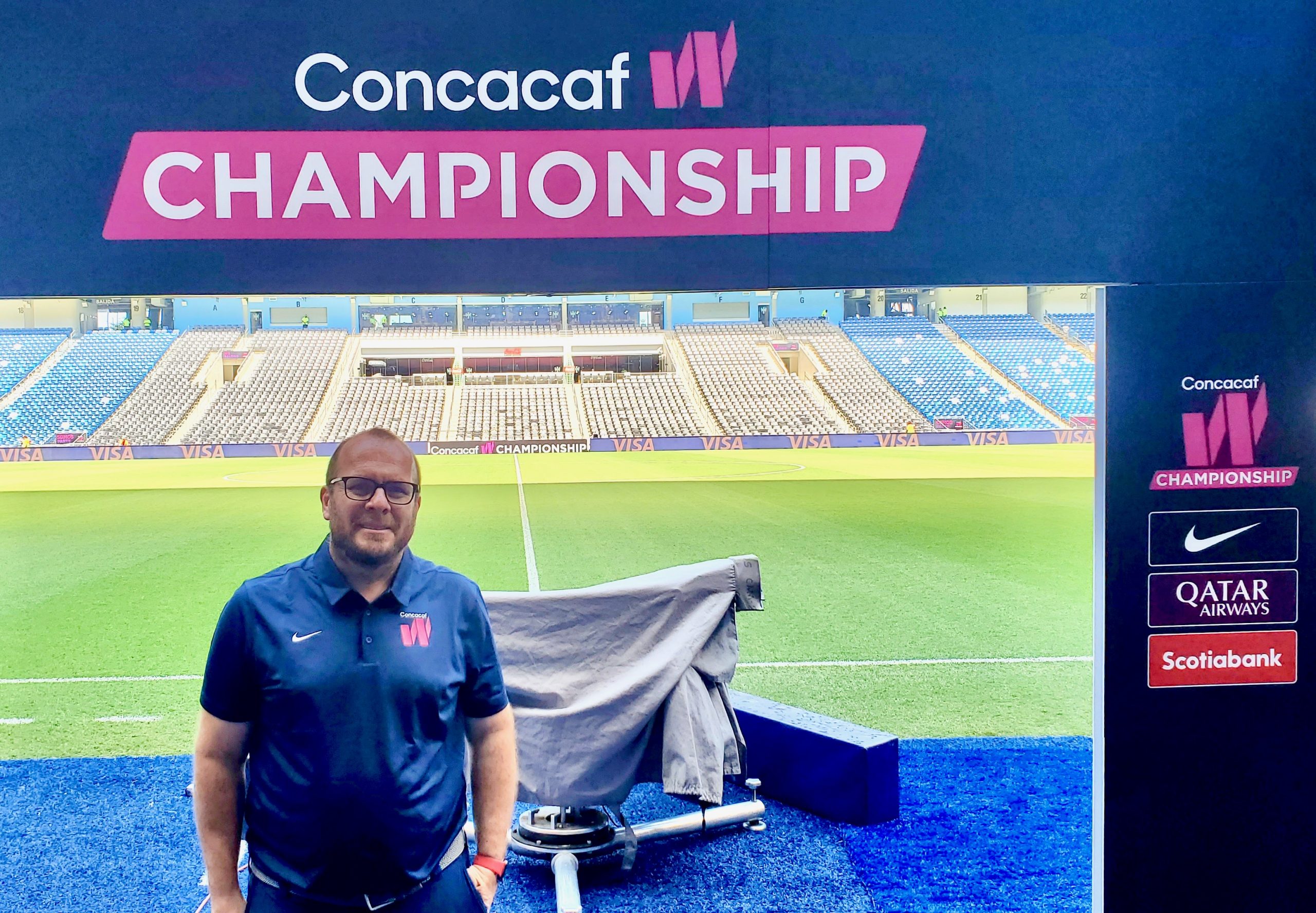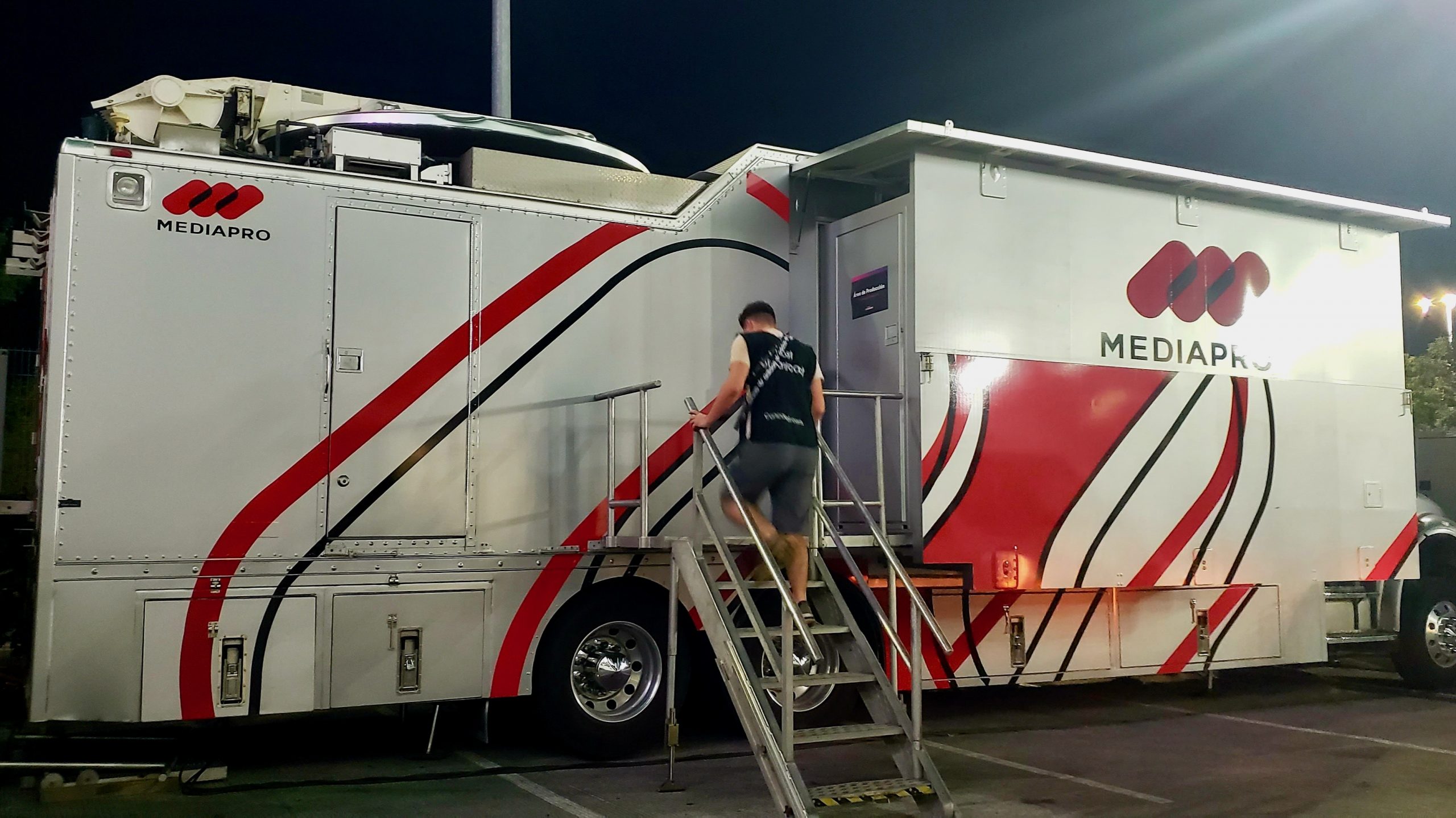Live From CONCACAF W Championships: Oscar Sanchez Leads International Production Effort in Mexico
Besides showcasing women’s football, the goal is to boost women’s career opportunities
Story Highlights
The trek to the 2023 FIFA Women’s World Cup and the 2024 Olympics is under way in Monterrey, Mexico, where CONCACAF is holding its 2022 CONCACAF W Championship July 4–18. With eight teams divided into two groups of four, the top two teams of each round-robin group qualify for the World Cup, and the two third-place teams advance to a playoff (the winner also qualifies for the 2024 Olympics). For Oscar Sanchez, director, broadcast operations/executive producer, CONCACAF, it’s all part of an effort that has produced and delivered 160 women’s football matches to fans this year.

CONCACAF’s Oscar Sanchez: “We’re investing heavily on this one. We want the coverage to look as good as the men’s coverage looks.”
“This is a good place to do football because this is a football town,” he says. “It’s challenging because we’re putting together two different production teams: we have a UK-based team working with a Mexican team. It has been fun, and we’re happy so far with what we are seeing.”
With the Women’s Euros also kicking off this week and the CONMEBOL Women’s tournament starting soon in Colombia (and another women’s tournament in Asia as well), women’s football is getting a global push, and Sanchez says CONCACAF is making sure the production shines.

From left: CONCACAF W Championships Technical Director/Vision Mixer Niahm Bhreathnack, Director Grant Philips, and Producer Laura McDonald call the front bench in a Televisa production truck home July 4-18.
“It’s very important that we look as good as the others, and we’re investing heavily on this one,” he says. “We also want the coverage to look as good as the men’s coverage looks. That’s why we decided to bring in Director Grant Philips, one of the best soccer directors in the world, with his crew. We wanted to bring in a proper crew for this.”
The team from Europe includes a vision mixer from Ireland, an EVS producer, two EVS operators, two camera operators, and a floor manager.
Sanchez says bringing over a UK-based production team that works on big international matches is important because the gold standard in football production has a UK feel.
“Directing in football is subjective,” says Sanchez, “but, at the end of the day, what you see in European football, Champions League, and the Premier League is what fans are used to. We want to give women’s football in the region the best level of production possible. In this region, we have the U.S., which are the World Cup champions, and Canada, which is the Olympic gold-medalist team. This is a great opportunity for the world to see the best players and to showcase them.”
The core team from the UK is complemented by a Mexican production team as well Producer Laura McDonald, who is from Jamaica. McDonald’s profile in the industry rose after she completed the HBS Broadcast Academy, which is an international effort focused on development of next-generation talent via intensive training combining real-world experience and training from some of the best directors and production professionals on the planet. Also on the team is EVS operator Ashley Moore, likewise a graduate of the HBS Broadcast Academy, as Sanchez and CONCACAF look to create a talent pool across the Caribbean and beyond.
“We’re trying to link what we’re doing with the Broadcast Academy,” says Sanchez. “Laura was probably one of the first to come out of the Broadcast Academy, and now she’s producing the most important women’s event in the region and is also going to Qatar for the FIFA World Cup. She’s a great storyteller, she knows the sport and teams, and she’s great at all the skills a producer needs: she’s organized, knows the structure, and has knowledge in other production areas, like directing and being a venue manager. She has a holistic view of the process; we love that.”
The tournament is an intense run for the production teams. Two venues are in use: Estadio Universitario and BBVA (which will host 2026 World Cup matches). In the group stage, a single crew will produce a doubleheader of evening matches at 6 p.m. and 9 p.m. local time, with match days alternating between stadiums.
“We’re using the Televisa truck that they use to produce the Liga MX matches here as there are two teams in Monterrey with a huge fan base,” says Sanchez. “MediaPro is also providing some resources like an EVS IPDirector for us as they have a presence here in Mexico.”
There will be four matches on July 11, with a Mexican production crew handling two of the matches and the Scottish crew producing the others. The group-stage productions will be done with 16 cameras, a drone, and a super-slo-mo camera system.

CBS Sports reporter Jenny Chiu interviews USWNT head coach Vlatko Andonovski ahead of the U.S. team’s 5-0 win over Jamaica on Thursday night.
For the knockout stage, the production will add a Cablecam and a couple more super-slo-mos. And rightsholders CBS Sports, ESPN Mexico, Canada’s One Soccer, and TUDN will increase their onsite presence with studio shows and on-air talent.
“From the semifinals on,” says Sanchez, “CBS will bring in a big team of around 120 people for the studio show, which will feature some legends and former players. They will also call the games from here. CBS has been doing a great job with women’s football, and we can tell they are putting forward a great effort in support of this tournament.”
The efforts are also a mix of onsite and remote operations, with graphics and commentary handled from Vista Worldlink in Miami.
“We’re sending all our clean feeds back to Vista,” Sanchez explains. “They integrate everything there, like graphics and commentary, and distribute to rightsholders. One thing Vista has been really good at is sourcing women and giving them an opportunity to grow their careers.”
Distribution to rightsholders is via Vista and The Switch and the latter’s MiMiC Distribution Platform.
“That has been really good for us,” says Sanchez. “We have produced 300 games in the first part of the year, and all of them have been distributed through the MiMiC cloud distribution. Each rightsholder gets an SRT, and, while at first some were hesitant, they love it. It is way cheaper than satellite and less complicated, and the quality is really good.”
The match-coverage improvements are also being enhanced with the addition of a content feed, something CONCACAF has been developing with HBS.
“We put everything that we cannot put on the main feed, like live player arrivals, and, if there is a goal, there are 19 angles of the goal,” Sanchez says. “We give the rightsholders everything for things like social pieces that they want to produce. We are producing those throughout and increasing the amount of content from the semifinals on.”
Redundancy is also a big part of the effort (and a pet passion for Sanchez). “It helps me sleep better,” he says. “We’re doing satellite for the main transmission from here, and we have a fiber company called Gold Data that has connectivity throughout Mexico, Central America, the Caribbean, and even South America. They’ve been a good partner throughout the years, and they are doing the additional content feed and backing up the main feed.”
The efforts during this tournament are all part of CONCACAF’s goal to grow women’s football in the region. The additional production tools lift the quality, which lifts the viewership, which lifts support of women’s football across the entire region.
“No matter your gender,” says Sanchez, “you need to be able to play the sport that you want. The other thing is, we need to give women the opportunity to have more doors open for them to play, because it’s not the same as a boy, who gets a ball [while] a girl gets a doll. If a girl likes to play football, we want to be sure that she can go to a place to play and be treated respectfully.”
Those efforts extend into the broadcast realm, where Sanchez sees a big opportunity to develop the quality of the game via events like this as well as the NWSL and the USL in the U.S.
“The possibilities are endless because the fans have not discovered it yet and the rating returns are growing at an average that is higher than the men’s game,” says Sanchez. “We see a business opportunity as well. Hopefully, sponsors will get behind it, and the fans can have more opportunities to watch it. The thing for us, is you cannot put the women’s game in front of the fan at a quality that looks worse than the men’s coverage. These women are super-talented, and they are tough stars with a huge fanbase that follows them in any platform. We need to try to respect that.”
That respect extends behind the scenes as well: 20% of the production team is female, a relatively high number in a country where women are not as numerous in production as they are in the U.S. or Canada.
“We hope to open the the doors for women because, nowadays, it’s just a matter of make the decision and give them the opportunity to get behind the EVS or a chance to be producers of their own show,” says Sanchez. “It’s challenging because there’s not enough women available, and we need to do a better job sourcing those women that are available and opening more opportunities.”
He believes the move to remote operations might increase those opportunities. “I think that remote production is going to open more doors for women because, if they are a talented operator, they can be operating from home instead of traveling across the country to do a big game. They can do it from home if they have the right connectivity. We had a woman who lived in Phoenix, and she was so excited because she was a graphics operator who could put her kids to bed and then work from home. I think the opportunities are coming.”


